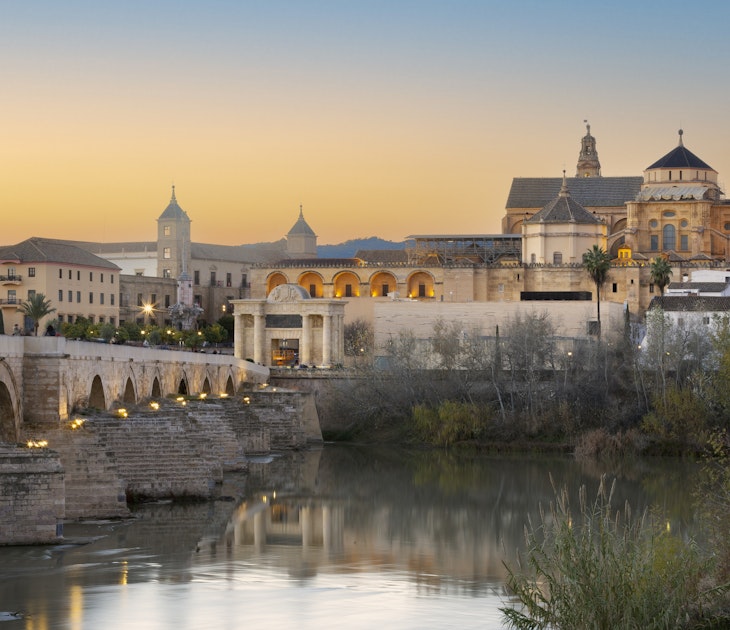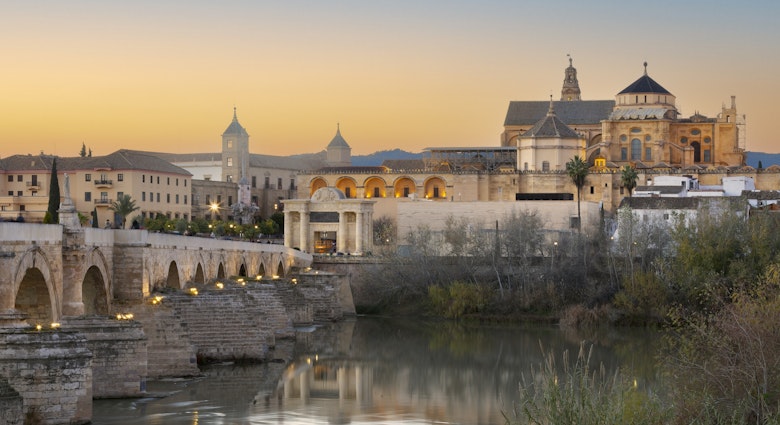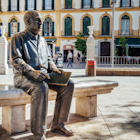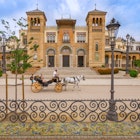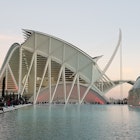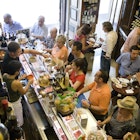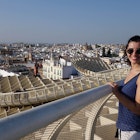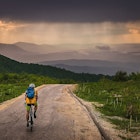The audience in Seville’s Casa de la Guitarra is crammed in like a football crowd at a Barcelona-Real Madrid game, but it doesn’t seem to matter. All eyes are on the stage where the singer, dancer and guitarist have fused to create a wall of emotion so intense you could practically light a cigarette with it.
Shoes clack, the guitarist’s hand disappears in a blur of strumming, the singer lets loose a long agonising wail; and then suddenly it’s over and all you’re left with is the faint echo of the final chord and the feeling that something profound has transpired.
Performers at Seville's Casa de la Guitarra. Image by Casa de la Guitarra
New venues
Flamenco in Andalucía is in the throes of a minor renaissance. Half a dozen new live venues owned and operated by knowledgeable flamenco enthusiasts coupled with three recently inaugurated museums in Seville, Córdoba and Almería have rejuvenated interest in Spain’s soulful art form and offered fresh opportunities to appreciate it in an undiluted and authentic way.
Performers at Seville's Casa de la Guitarra. Image by Casa de la Guitarra
Named an intangible cultural heritage by Unesco in 2010, flamenco has been around in its modern form since the late 19th century. What began as an esoteric art practiced at wild Roma parties has been catapulted into the mainstream, where it has been mixed with jazz, rock and contemporary dance.
Nonetheless, after decades of innovation and experimentation, flamenco’s recent renaissance is more about the past, inspired by a desire to re-explore the music’s foggy Roma roots. Eschewing the large concert hall-sized shows, known as tablaos, that have entertained tourists for decades, Andalucía’s newer venues fashion themselves as cultural centres and are bereft of the bars, restaurants and large seating capacities of their glitzier cousins. Instead of hosting theatrical extravaganzas, typical cultural centres hold powerful one-hour shows in which a talented combo of singer, guitarist and dancer cover a variety of flamenco palos (styles) with a strong bias towards cante jondo (deep song), the art’s raw and stripped-down foundation block.
With room for only 60 or 70 guests, who sit so close to the stage they can literally feel the swish of the dancer’s dress, cultural centres are atmospheric and intimate. More importantly, as well as showcasing the finely-honed skills of the performers, they encourage the fermentation of flamenco’s crucial fourth element: the jaleo, or audience participation. Urged on by exuberant óles from regulars in the crowd, the performers on stage drive the music towards a dramatic climax which, on good nights, can invoke a mythical spiritual awakening known as duende.
'Pure' flamenco in Seville
Most cultural centres are run by respected flamencologists (experts in flamenco). Seville’s Casa de la Guitarra (Calle Mesón del Moro 12, www.casadelaguitarra.es), which opened in 2012, was founded by José Luís Postigo, a celebrated flamenco guitarist who regularly books Andalucía’s best performers and has set his club up like a mini-museum with glass display cases filled with antique guitars. Nearby and in the same vein is the diminutive family-operated Auditorio Alvarez Quintero (Calle Álvarez Quintero 48, www.alvarezquintero.com) close to Seville’s famous cathedral. The Casa del Flamenco (Calle Ximénez de Enciso 28, www.lacasadelflamencosevilla.com) in Seville’s medieval Santa Cruz quarter was recently put under new management and is encased in a beautiful 15th century house full of decorative tiles and shifting shadows. A few streets away, lies the Museo del Baile Flamenco (Calle Manuel Rojas Marcos 3, www.museodelbaileflamenco.com), a flamenco museum owned by renowned Seville dancer Cristina Hoyos, which doubles up as a flamenco school and venue for nightly shows.
The Casa de la Memoria's new centre in Seville. Image by Casa de la Memoria
Quiz an aficionado, however, and they might say that Seville’s best flamenco venue is the Casa de la Memoria (Calle Cuna 6, www.casadelamemoria.es), which relocated in November 2012 to El Centro where it has added an exposition centre to complement its twice nightly shows. Located over two floors in the former stables of the adjacent Palacio de Lebrija, the centre utilises some of the top performers in Spain. Witness guitarists who play like they’ve got three hands or vocalists who sing as if their hearts have been broken minutes before arriving on stage.
Granada's Casa del Arte Flamenco. Image by Brendan Sainsbury / Lonely Planet
Granada, Córdoba and Almería
Although Seville is at the centre of Andalucía’s rekindled interest in ‘pure’ flamenco, the trend has been echoed in other cities. In Granada, the Casa del Arte Flamenco (Cuesta de Gomérez 11, www.casadelarteflamenco.com), launched in 2013 at the foot of the Alhambra hill, shares similar attributes to Seville’s Casa de la Guitarra being small, locally run and passionate about its art. Meanwhile, up in the Albayzín, Granada’s old Moorish quarter, Jardines de Zoraya (Calle Panaderos 32, www.jardinesdezoraya.com) retains the air of a more traditional tablao offering flamenco with drinks and dinner. The leafy patio has plenty of plaudits.
Estefanía Martínez performs at Granada's Jardines de Zoraya. Image by Emiliano Artigas / Jardines de Zoraya
Andalucía’s former Moorish capital, Córdoba might lack the flamenco pedigree of Seville, but it gained what is perhaps the best flamenco museum in Spain in 2013 with the opening of the Centro Flamenco Fosforito (Plaza del Potro, www.centroflamencofosforito.cordoba.es/el-centro/museo-fosforito) in an old tavern once name-checked by Cervantes in Don Quijote. The wonderful interactive museum explains everything you need to know about flamenco’s highly complex art, using rare archive film and music. Regular live music is organised on the historic patio.
Almería is another often overlooked flamenco outpost that spawned Tomatito, one of the finest guitarists of the modern era, and Antonio de Torres, the man who practically single-handedly invented the modern Spanish guitar. The city’s Museo de la Guitarra (Ronda del Beato Diego Ventaja, www.turismodealmeria.org/es/motivo-tematico/museo-de-la-guitarra_496), which opened in December 2013, pays homage to Torres and his guitars and invites visitors to have a strum themselves.
A performance at Peña La Perla in Cádiz. Image ©Tatis Fotografia
Flamenco in Cádiz and Jerez de la Frontera
It would be remiss to talk about flamenco in Andalucía without mentioning Cádiz and Jerez de la Frontera, the cities that produced so many of the genre's greatest artists. Jerez is unique in that its cultural centre, the Centro Flamenco Andaluz (Plaza de San Juan 1, www.facebook.com/CentroAndaluzdeFlamenco) is home to Spain’s only flamenco library. Cádiz has many venues, including what is possibly the best and most welcoming peña (private flamenco club) in Spain. Peña La Perla (Calle Carlos Ollero, www.laperladecadiz.es) puts on stirring shows every Friday night in its headquarters beside the crashing Atlantic surf. Providing newer competition. Cintfla (Calle Santiago 12, www.cintfla.com) opened in October 2013 styling itself as a flamenco interpretation centre. It contains a mini-museum full of audio devices, along with a recreated Cádiz taberna, and a mural of singer Camerón and guitarist Paco de Lucía. Check their Facebook page for concert schedules.
Most cultural centres in Andalucía offer one-hour-long flamenco shows twice nightly for around €18 a ticket. In peak season (May-August), it is best to book in advance. For more information see www.flamencotickets.com
Brendan Sainsbury is a Granada-lover and Flamenco addict who has contributed to four Lonely Planet Spain guidebooks. He has also written Lonely Planet guidebooks to Cuba, Italy, Peru and Seattle.








